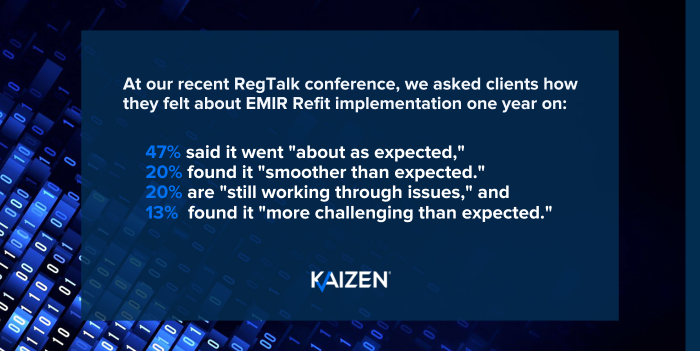ESMA’s 2024 Data Quality Report: EMIR Refit under the Microscope

ESMA released the fifth iteration of its Report on Quality and Use of Data (DQR) late last month, which highlights the use of reported data across multiple regimes, critiques submission quality, and references some of the enforcement actions carried out in 2024. This analysis focuses on the DQR’s EMIR data quality findings and their implications for firms. We have also published our SFTR analysis of the report.
Focus on EMIR Refit
Last year’s DQR placed a heavy emphasis on the potential for the EMIR Refit reporting changes to improve data quality. 12 months later, ESMA provides a mixed assessment:
- ‘Positive assessment of go live’ in April 2024
- Concerns regarding preparedness of Trade Repositories and reporting entities
- Ongoing ‘need for further engagement for corrective actions’.
EMIR Reporting was described by ESMA in last year’s DQR webinar as being ‘much more complicated’ under EMIR Refit. From Kaizen’s view of post-Refit reporting, many firms still have significant work to do to uncover hidden reporting issues and apply successful remediation procedures. This report may still be too early to provide a true reflection of data quality under the EMIR Refit regime.
Limited Data Quality Indicators (DQIs)
The EMIR metrics provided in the report give a limited and somewhat lacklustre view on where EMIR data quality currently rests. Of the seven DQI metrics displayed:
- Six show a mild improvement in data quality metrics (such as the Number of Outstanding Trades in Chart 3)
- One indicates declining quality – percentage of missing valuations (Chart 7).
A more comprehensive analysis of all the EMIR DQIs would be extremely useful for the industry and help us to gain a more accurate evaluation of data quality. ESMA’s Data Quality Dashboard for EMIR Refit document details (approximately) an additional 18 DQIs (c.25 in total) that are being actively monitored and discussed between supervisory authorities. The DQIs are a key tool within their regulatory arsenal and it is disappointing only a small number appear in the public report.
Key DQI findings
Rejection rates
ESMA highlights the rejection rate of derivatives, which sits at approximately 1-2.5% across EU submitters. The rejection rate is described as ‘critical for authorities’ to ensure data is complete and accurate. ESMA’s expectation is for a ‘close to zero’ rejection rate.
For me, the late report statistic is far more important, as firms are required to report trades in a timely and accurate fashion. Late submissions by some counterparties can lead to the view of unpaired submissions that distort the visibility of derivative exposure. Firms are required to report by end of day T+1, and are not in breach of any regulatory requirements if they resubmit a rejected derivative within that timeframe. In the absence of any material increases in this statistic, I question the value of emphasising it.
Legacy format upgrades
The DQR states that ‘36 million’ submissions needed upgrading to the new EMIR Refit format within 180 days from April 2024. At the end of February 2025, 2% of those submissions had not been converted. Firms with a UK EMIR reporting obligation should take note of the focus on updating old submissions and enforcing the strict schemas under EMIR. ESMA states firms should ensure ‘swift upgrading’ of any old format derivatives.
Maturity date issues
Abnormal or blank maturity dates continue to cause confusion (as shown in Chart 6), despite a small reduction to approximately 10% of submissions. Due to products such as CFDs, the maturity date fields have not been mandatory under EMIR Reporting’s validation rules, long prior to EMIR Refit. Regulators fully expect these ‘optional’ fields to be populated where applicable to the derivative. It is worth repeating:
Optional fields do not mean the entity has a choice as to whether they are populated or not.
Abnormal or blank maturity dates is a relatively high figure at 10% and ESMA explicitly expects a ‘lower percentage going forward’. Firms must ensure that this data point, and all further ‘optional’ fields are fully reviewed and are being reported for all submissions in a timely and consistent manner.
Missing valuations
Chart 7 shows that missing valuations are increasing (currently at 12.36%), even though daily valuations are required for a large majority of EMIR reporters and have been since August 2014.
Entity Responsible for Reporting (ERR)
The DQR also places emphasis on a new field from EMIR Refit, the Entity Responsible for Reporting (ERR). This OTC field is described as a ‘crucial addition under EMIR Refit’ and ESMA appears dissatisfied with the volume of misreporting of this field (as shown in Chart 6).
Trade Repositories’ (TRs) challenges
ESMA gives mention to the reporting difficulties of TRs as well as entities, including issues such as:
- Difficulty with reporting portability
- LEI updates from M&A activity
- Inter-TR reconciliation delays
- Challenges providing complete reports to the NCAs.
In my opinion, this highlights the complexity of EMIR Refit for firms and TRs alike, notably given the vast range of reportable products and lifecycle events, under a complicated reporting regime.
The simplification paradox
ESMA makes efforts to explain its desire to simplify reports and reduce the regulatory burden for firms. Very few firms will agree that this objective has been achieved in practice or in the spirit of the regulation. While many aspects of reporting have received welcome clarification, additional reporting requirements have been introduced and made the overall regulatory regime much more complex.
What does this mean for firms?
Based on the DQR findings, firms should focus on:
- Ensuring proper population (where applicable) of maturity data fields
- Valuation reporting – review processes to stop the increasing trend of missing valuations
- ERR field accuracy – verify the correct implementation of this ‘crucial’ addition
- Legacy migrations – complete any remaining pre-Refit format submission upgrades
- Rejection rates vs late reporting – while ESMA focuses on rejection rates, firms should also prioritise timeliness.
Assessment
Overall, I welcome the DQR’s attention to data quality critique and its motivation to help firms achieve regulatory compliance through complete, accurate and timely reporting. The justification of how data is used is particularly valuable, as this large operational burden is often questioned by firms.
Going forward, the DQR would benefit from further transparency and metrics across the full suite of DQIs. This would help firms understand how their reporting is being reviewed by supervisory authorities and allow them to focus their limited remediation resources on improving the most material parts of EMIR Reporting.
Better guidance and clarity would also ensure firms are better equipped to ensure reporting is complete and accurate at point of submission, negating the need for costly remedial action for firms and regulators alike.
Concerned about the quality of your EMIR Reporting data? More than 200 firms from tier 1 banks to small fund managers rely on Kaizen’s quality assurance to meet – and exceed – their regulatory obligations. Contact us to request a demo or for a conversation with one of our regulatory experts.


